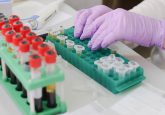Ionic liquid microarrays show promise for new lab-on-a-chip design
Microarray developed by Australian scientists demonstrates benefits over traditional lab-on-a-chip design.
In a recent publication in Nature Communications, researchers from the University of New South Wales (Sydney, Australia) present a novel lab-on-a-chip system that attempts to address current problems experienced with these devices – including solvent volatility and lack of reproducibility. The system uses ionic liquids that are chemically anchored to the chip, rather than using more traditional channels and reservoirs.
The chip is manufactured using microcontact printing, to produce a “robust and versatile” system, for use in both microreactor and microfluidic devices. The team has demonstrated the applicability of their system as both electrochemical cells and substrates for protein immobilization, in addition to its use as a membrane-free amperometric gas sensor array – highlighting the versatility of the system.
The system is also robust, as senior author of the study, Chuan Zhao, explained, “These microarray chips can be easily produced in high numbers and are very stable. They can survive being turned upside down and heated to 50 degrees and some can even survive being immersed in another liquid. These properties will be important for commercial applications, including storage and transportation of microchips.”
The team highlight the advantages of their system, explaining that the system overcomes problems in solvent volatility and slow mass transport in viscous ionic liquids. Zhao explained, “We use a class of ‘green’ solvents called ionic liquids, which are salts that are liquid at room temperature. They are non-volatile, so this overcomes one of the main problems in making useful miniaturised devices – rapid evaporation of the solvents on the chip.”
The team envisages their system could have applications in a diverse range of applications including diagnostics, environmental monitoring and process control in manufacturing. At 50 µm width and 10 µm height, the system offers the standard advantages in miniaturization, while addressing traditional deficiencies in these systems.
Source: New lab-on-a-chip device overcomes miniaturisation problems.






